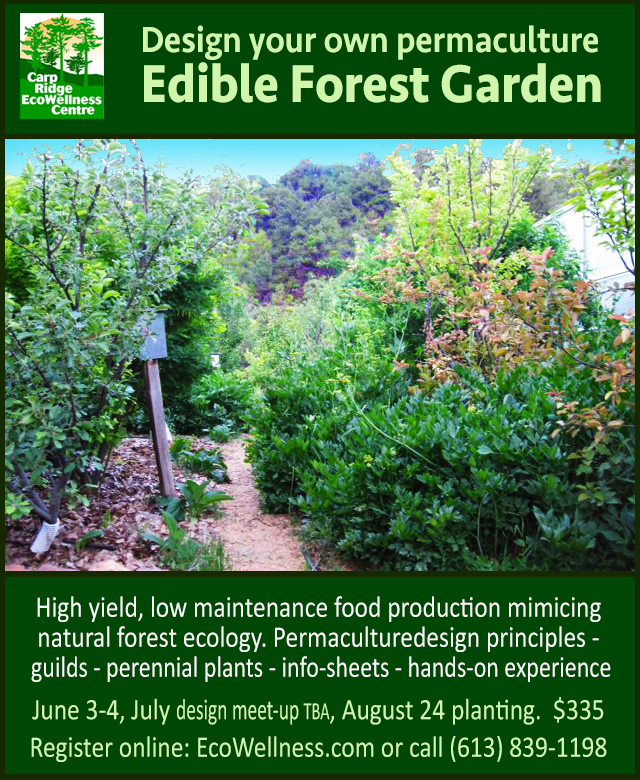Edible Forest Garden Design
An idea whose time has come
Kaia Nightingale
When I look at how much less labour is needed to put perennial food on my plate rather than annual, I scratch my head, wondering why on earth we have been so focused on annuals that need seeding and pricking out every year when perennial plants live for years. Perennials also have deeper roots, so need less irrigation since they are able to draw water annuals can’t reach. Welcome to forest gardens!
The word ‘forest’ in edible forest gardens isn’t about size. It’s about creating an ecosystem that is self-sustaining the way a forest is. We take it for granted that we don’t have to go into the forest to water, fertilize or weed it. If our forests were full of edible plants, our dinner plates would fill right there.
Any size you choose
Edible forest gardens can be sized to fit in your back yard, offering an elegant, sustainable, low labour, low carbon food solution.
A well designed edible forest garden requires much less maintenance, and can provide more food per square meter than conventional farming. Picture a high canopy of trees bearing fruit and nuts, bushes laden with berries, the ground thickly covered with succulent leaves, fragrant herbs and edible flowers to beautify both your garden and your dinner plate.
How does it work?
Permaculture principles are used to design polycultures of plants that each serve several mutually beneficial purposes – nitrogen fixers, insectaries, dynamic accumulators and of course, food production. A variety of height is used to maximally capture sunlight.
Permaculture is a way of growing food in a holistic, integrated way that is aligned with the natural world. If we mentally decide to plant a bush somewhere where that kind of bush isn’t happy – perhaps there is insufficient or too much sun or water, or where the soil pH or temperature isn’t right, we have to constantly tend that bush or it will die. This is labour intensive. If we plant that bush where it conditions suit it, and surround it with mutually supportive plants, it will thrive all by itself.
Where can we plant them?
Our garden lawns are tremendously labour intensive. They offer us a flat open place that is often hardly used. Imagine replacing a lawn with an edible forest garden. Imagine taking a basket at dinner time, entering your edible forest through curved paths that weave their way numerous different plants to a mystical, shady area, with a seat, designed in, waiting for your moment of solitude. You return to your kitchen with fresh salad makings, tasty herbs, cooking greens, fresh fruit for desert, and the deep sense of peace, resilience and integrity. The following spring, you delight in the leaves peeking up from the earth – without any effort on your part. You have no need to buy nitrogen fertilizers – since your nitrogen fixers do their job, no need for chemical pesticides since your insectaries will be attracting beneficial insects. Minerals washed deep into the soil are drawn back up through the dynamic accumulators. The soil is quickly covered by perennial leaves, which help to keep moisture in the soil and prevent weeds.
Permaculture – an evolutionary step forward
Your serene seats awaits you to delight in watching nature do what she does best – grow abundantly.
These same permaculture principles work socially in our lives too. As permaculture expert Dave Jackie writes, “Forest gardening helps us take our rightful place as part of nature doing nature’s work, rather than as separate entities intervening in and dominating the natural world.” Permaculture food gives us time for stillness. Rather than working against the natural world, permaculture food gives us a way to work harmoniously with it, providing all-round benefit.
Next Edible Forest Design Course – go here

Edible Forest Garden Design
Teachers: Julie Salter and Kaia Nightingale
Forest gardens are about mimicking forest ecology to create self-sustaining food production with high yield and minimal work input. They can be any size, and can fit in an urban backyard. The skill is in mutually supportive polycultures and guilds that suit the particular soil, sun and irrigation conditions. This course will give you the skills to start your own forest garden. As a group we will design and plant a garden so you have theory and practice.
Weekend intensive: Surveying the land (already cleared and mulched) at different times of day: Observing soil, water, sunlight. Permaculture principles – paths & patterns, stacking functions. Perennial plants – good yielding low disease, nitrogen fixers, dynamic accumulators, insectaries. Choice considerations: food preferences, availability, budget and land considerations. Design considerations: designing for fully grown plants.
Assignment: design an edible forest garden for this piece of land. You can work individually or in pairs. Designs gathered (cell phone jpg and written text can be e-mailed.) Designs shared between participants
*Design review: Date and place by consensus. Skype possible for those on holiday. Choosing elements from the designs for the final garden.
Planting day – Planting the garden!

